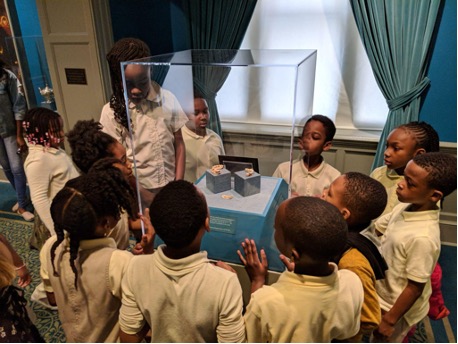Revolutionary Narratives, Part 3
Reconsidering Commemorations at the U.S. 250th
This past summer, over twenty OI Associates from the U.S. and Canada rose out of their beach chairs once a week to tune into an OI Coffeehouse on the 250th anniversary of the founding of the United States. Organized by Maria DiBenigno, Hilary Miller, and Amy Speckart, three members of the Revolutionary Narratives working group, the Coffeehouse asked participants to reflect on past commemorations in the U.S. and prognosticate on what 2026 will look like at historic sites, museums, libraries, archives, schools, and universities.
Uncommon Sense has been sharing some of the broad thinking that the Coffeehouse inspired in a three-part blog series.In the third and final part of this series, we explore how the U.S. Semiquincentennial is an opportunity to think expansively and inclusively about the legacies of the American Revolution.
Part 3: Thinking Expansively and Inclusively about the U.S. 250th
The U.S. Semiquincentennial is a bright opportunity to attract public support for the humanities. The last major U.S. birthday, the Bicentennial, launched the academic field of public history, widened the scope of historic preservation, and popularized living history. Many historic sites and museums that were born out of the Bicentennial would welcome funding to conduct research, update interpretation, train staff, and improve grounds. With little direction at the federal level, though, planning for 2026 varies widely among states and localities. This in turn leaves staff with little protection from political storms. One theme that emerged from the OI Coffeehouse is how to accommodate traditional audiences, who affirm their patriotism through nostalgia, while remaining committed to DEI practices.
Several coffeehouse participants favored the word “expansive” over “inclusive” to avoid alienating members of the public who are uncomfortable with the DEI label. OI Coffeehouse guest speakers Matthew Keagle, PhD, curator at Fort Ticonderoga, and Sara Evenson, a PhD candidate at SUNY Albany, gave excellent examples of expanding upon popular battle reenactments and living history military encampments to educate audiences about a wide range of topics, including history of medicine, family life, foodways, and geography. A seemingly familiar subject, eighteenth-century warfare, became a window into many worlds. Politics still entered the conversation, though; Keagle and Evenson addressed a recent New York state law intended to reduce gun violence that inadvertently hampered living history programming.
Are traditional narratives a help or a hindrance in attracting audiences to American history? After OI Coffeehouse discussions about Broadway trends, I’ll buy a ticket to the new 1776 stage production to see how artists are addressing this question.
—Amy Speckart, PhD, is an independent scholar and Assistant to the Director of Rare Book School at the University of Virginia

I teach kids about teeth. I teach them how to brush and floss and show them how Mayans ornamented their teeth with gems. I teach them about the tooth-shedding biological adaptations of sharks and show them an ivory denture once owned by George Washington. Kids and adults alike are often shocked to learn that when inaugurated, Washington had only one remaining tooth.
Washington’s oral health history exemplifies a reality many Americans still face: that stigmatizing tooth loss can happen to anyone. Per the Centers for Disease Control, the most common chronic disease of childhood in the United States is tooth decay. Yet, across the country, access to routine dental care remains inequitable, especially for low-income individuals and people of color.
The National Museum of Dentistry (NMD) proudly operates in Baltimore City, one of roughly 6,500 federally-designated Dental Care Health Professional Shortage Areas in the United States and its territories. Here, of all places, what do Washington’s dentures mean? How should we interpret this assistive device that salvaged his image as a national leader, in a place where for many, dental care is out of reach?
As NMD Education Coordinator, I look to 2026 as an opportunity to consider our national values, take inventory, and reflect not only on the journey of our nation thus far, but on the injustices and inequities we have yet to address. I hope other non-Revolutionary museums will do the same. Together, we can use this milestone anniversary as the inspiration for a national conversation about where our country needs to go, and how we do better in our pursuit of life, liberty, and happiness.
—Elise Petersen is the Education Coordinator at the Dr. Samuel D. Harris National Museum of Dentistry
The Revolutionary Narratives Working Group, made up of public history practitioners and academic scholars, is dedicated to fostering discussions about how to achieve a diverse, inclusive, and equitable U.S. Semiquincentennial. You can say hello to us in person at OAH 2024 in New Orleans at our session titled, “To 2026 or not to 2026? Commemoration, Reflection, and the Role of Historians in the U.S. Semiquincentennial,” or email us at RevolutionaryNarratives@gmail.com.

Leave a Reply